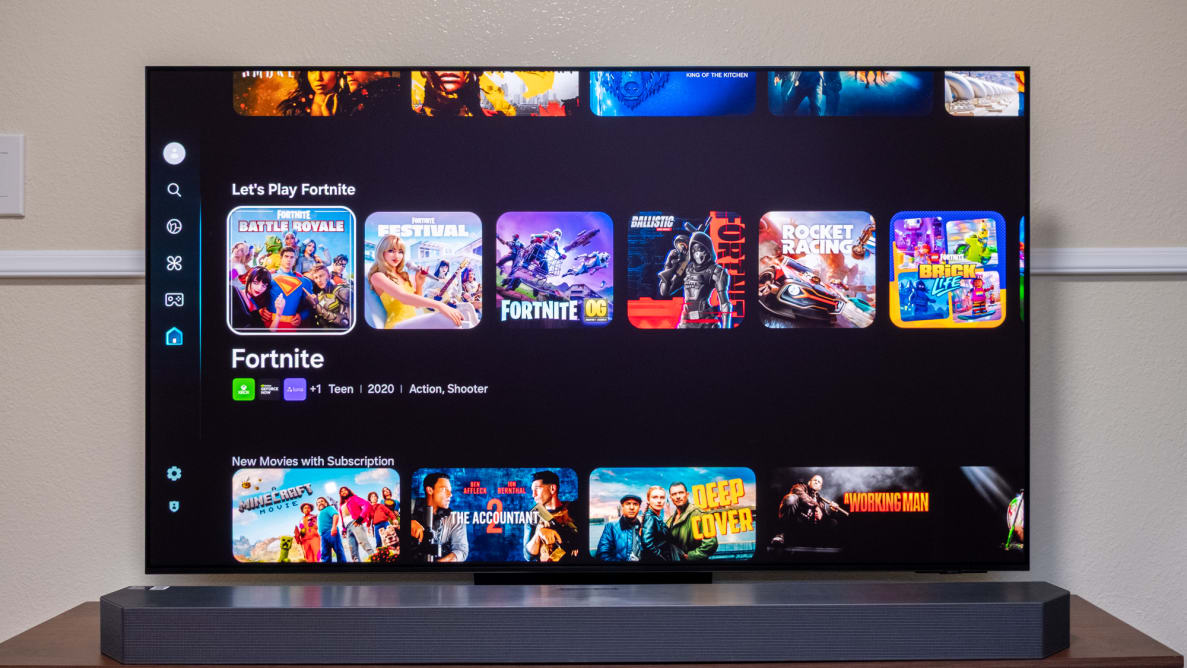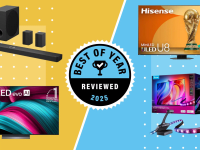Pros
-
Incredibly thin footprint
-
Vibrant picture quality
-
Unique anti-glare coating
Cons
-
More expensive that competition
-
Operating system software doesn't inspire
-
No Dolby Vision
About the Samsung S95F 55-inch Class OLED 4K Vision AI Smart TV (2025)
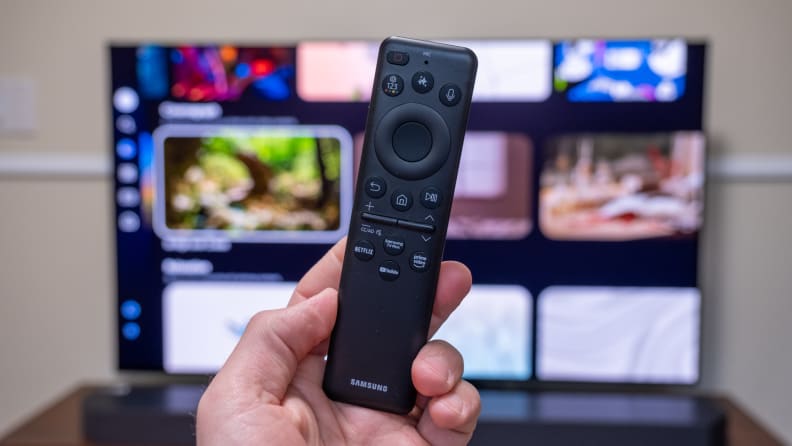
The remote that comes with the TV isn't quite as premium-looking, but I still like it. It's compact and lightweight, offering all the basic software controls you need.
- Resolution: 4K (3,840 x 2,160)
- Display type: QD-OLED
- HDR support: HDR10+, HDR10, HLG
- Dolby Atmos: Yes
- eARC support: Yes (HDMI 3)
- Native refresh rate: 165Hz
- Smart platform: Samsung Tizen
- Auto Low Latency Mode (ALLM): Yes
- Variable Refresh Rate (VRR): Yes (up to 144Hz VRR on HDMI 1)
- Processor: NQ4 AI Gen 3 Processor
- ATSC 3.0 tuner: No
- **Sizes available: 55”, 65”, 77”, 83”
The Samsung S95F comes in four different sizes, ranging from 55 inches at its smallest size to 83 inches at its largest. Keep in mind the 83-inch model is not actually a QD-OLED TV, but rather has a traditional OLED panel with no quantum dot layer. Prices start at $2,299.99 for the 55-inch model and range up to $6,499.99 for the 83-inch model.
What we like
A thin footprint and nice details make for a stunning design
TV manufacturers have been working on ways to slim down their displays, and I'm a huge fan of this trend. Samsung has done so through the One Connect box, which houses everything you would normally find inside a TV, except for the display panel itself.
The result is that the actual display panel of the Samsung S95F is slender and very premium-looking. Because I was only using the TV for a few weeks, I didn't mount it to the wall, but if you did mount it, you'd get an almost wallpaper-like experience.
To be clear, it looks excellent on the stand that it comes with, too. The super-thin design makes for a premium build. When you use the stand, the One Connect box sits on the back of the stand to allow for easy access to ports. When you mount the TV to the wall, you'll make use of a longer cable between the two components.
For more flexibility in the placement of the One Connect box, you could, for example, route that cable through the wall to give the TV a floating look, or you could simply put it inside a TV stand or route it into a drawer to keep cables away.
Rest assured, even if you keep the One Connect box visible, the single small cable that connects the TV to that box is subtle and minimalistic.
The premium build quality is further helped by details like tiny bezels and strong build materials. Just don't let those fool you into thinking that the TV can withstand abuse. You'll want at least one other friend to help you set up the TV, as it can flex relatively easily.
The One Connect box houses a solid selection of ports, including four HDMI ports, all of which support the HDMI 2.1 spec for modern tech, like variable refresh rates. You'll also get an optical port and three USB ports.
The remote that comes with the TV isn't quite as premium-looking, but I still like it. It's compact and lightweight, offering all the basic software controls you need, along with quick access buttons for Netflix, YouTube, Prime Video, and Samsung TV Plus. I found it easy to use.
It has a bright, vibrant image quality
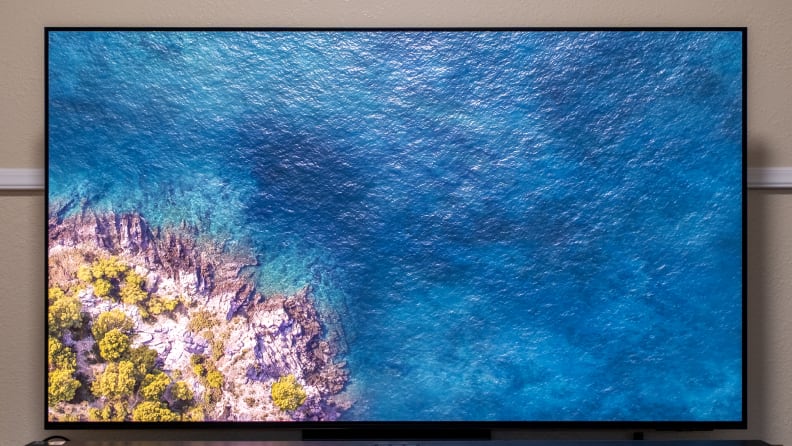
When you’re looking at a TV like the Samsung S95F, the most important element is its image quality, and this one stands up to expectations.
When you’re looking at a TV like the Samsung S95F, the most important element is its image quality, and this one stands up to expectations.
The TV offers a QD-OLED panel, with one caveat—if you get the largest size, which is 83 inches, you'll get a traditional OLED panel instead. I'm reviewing the 55-inch model, and I suspect most customers will go for it or the 65-inch variant, so most will end up with a QD-OLED TV.
The basic gist of QD-OLED is that it leverages OLED technology for the ultra-deep black levels and infinite contrast and combines it with a layer of quantum dots to improve brightness and give colors a more vibrant look. It works well, and while traditionally OLED TVs have been a little dim, the Samsung S95F is excellently bright.
That huge peak brightness is useful for all kinds of content. When watching HDR content, you'll get dazzlingly vibrant highlights that help make images look more realistic, especially when coupled with that true black level that you'll get from OLED panels.
The OLED panel also means that the TV can effectively avoid issues like blooming, and these issues haven't been completely solved on even the best Mini-LED TVs. When watching SDR content, you'll have a great experience, too. Content looks vibrant and colorful, easy to see even in bright rooms.
Its coating makes it excellent at avoiding glare
No one enjoys seeing the reflection of their living room ceiling light superimposed over the action scenes in their favorite movie. With a bright panel, the TV is also very good at avoiding glare, helping make brightness pop even more. Samsung has given the S95F a matte anti-glare coating, which is good at avoiding reflections. This anti-glare coating was used on last year's S95D, but I am still surprised at how well it works, even after having tried both.
Essentially, the coating disperses light in a way that a glossy coating can't. That means that if you're having trouble with glare from things like lights or a window behind you with your current TV, the S95F will at least help minimize those problems.
Indeed, I tested the TV with a window directly behind me, and I commonly have issues with glare from that window. I found it to be a non-issue here. Sure, it didn't magically kill all light from the window, but I barely noticed reflections.
Gamers will love it

The Samsung S95F is an excellent gaming TV. Its HDMI ports support HDMI 2.1, so you'll be able to take full advantage of things like variable refresh rate (VRR) to avoid issues like screen tearing and stutter.
The Samsung S95F is an excellent gaming TV. Its HDMI ports support HDMI 2.1, so you'll be able to take full advantage of things like variable refresh rate (VRR) to avoid issues like screen tearing and stutter.
Speaking of refresh rate, this Samsung TV supports a 165Hz refresh rate, which makes it great for PC gaming too, and not just for use with consoles. I had an excellent experience gaming on the TV, although I would have liked to experience these games in Dolby Vision on the TV.
What we don't like
The cost will dent your wallet, even for the 55-inch
The Samsung S95F is one of the most high-tech TVs on the market today, and you'll have to pay big to put it in your home. The TV starts at $2,299.99 for the 55-inch model, ranging up to a lofty $6,499.99 for the 83-inch model.
Software does not go above and beyond
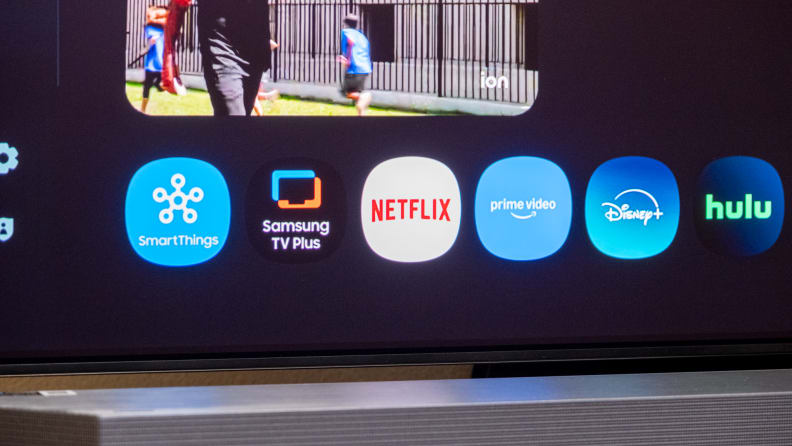
Samsung's Tizen operating system isn't bad, and it will allow you to access your favorite content from services like Netflix, Amazon Prime, and other streamers. That said, it can get cluttered.
Samsung's Tizen operating system isn't bad, and it will allow you to access your favorite content from services like Netflix, Amazon Prime, and other streamers. That said, it can get cluttered.
I also found that it often jumped to live TV services that I wasn't trying to navigate to. The home screen can be complicated at times, and while it is nice that Samsung seems to be working on ways to discover new content, its approach results in an experience that will leave many users confused.
This isn't necessarily an issue that everyone will have to deal with, though. While I used the software for a while, I also used the TV with an Apple TV 4K, which I find to offer a much better software experience.
Thankfully, the TV does support smart features like Apple AirPlay 2, Google Chromecast, and even Apple HomeKit, so you can integrate it with your smart home if you want to.
You won’t get to experience Dolby Vision
Samsung continues to refuse to adopt Dolby Vision, and, at this point, I doubt it will ever make the switch.
Instead, the company is implementing its HDR10+ format. And while HDR10+ can look great, plenty of content only supports Dolby Vision—not HDR10+. So, you can often find that you're missing out on getting the full dynamic range experience, depending on what you're watching. I would love to see a Samsung QD-OLED TV with Dolby Vision support—but I don't see that happening anytime soon.
Audio quality is lacking, so you’ll need an external sound system for deep bass
The speakers built into the Samsung S95F aren't bad, and they can get pretty loud. The bass response is fine, and I was able to hear dialogue decently well. But you won't get a very immersive experience, and it's still worth using an external sound system for actual deep bass and more detailed highs.
I was lucky enough to be able to test the Samsung S95F TV with Samsung's HW-Q990F soundbar, which offers one of the best audio experiences you can get. If you use it with one of these soundbars, the TV speakers can work with the soundbar to help improve audio and make dialogue clearer.
Should you buy the Samsung S95F 55-inch Class OLED 4K Vision AI Smart TV (2025)?
Yes, if you can afford it
If you take one thing away from this Samsung S95F review, let it be this: This is an incredible TV. Its high brightness means that HDR content looks stunning, and SDR content is easy to see even in brighter environments. Plus, it has a beautiful design and helpful gaming features.
As an alternative, the LG G5 OLED TV can get a little brighter, and some prefer LG's software, but the glossy coating means it doesn't handle reflections very well. Its build is also more than double Samsung’s S95F, because it has a more traditional TV design with everything built into it. In some environments, like darker rooms, the LG G5 OLED might be a better choice, especially for those who don't really care about design (and don't get me wrong, the G5 OLED still has a premium design).
All said, I think the vast majority of people should splurge for the Samsung S95F TV (available at Samsung for $3,299.00) , thanks to its anti-glare coating and its much sleeker and more stylish design, despite its high price tag.
Meet the tester
Christian de Looper is a consumer tech journalist with over a decade of experience. De Looper has covered all areas of the consumer tech industry, from smartphones to smart homes — and has attended all of the major trade shows, including CES.
De Looper has always been interested in consumer technology, but his love for gadgets and electronics blossomed into a full-blown passion when he started writing about it while completing his degree in audio production.
Since then, he has written for many of the top tech publications, including Digital Trends, Tom’s Guide, TechRadar, and many more. He loves getting his hands on all of the latest gadgets, but when he’s not reviewing tech, he can be found hanging out with his family or producing music.
Checking our work.
Our team is here to help you buy the best stuff and love what you own. Our writers, editors, and experts obsess over the products we cover to make sure you're confident and satisfied. Have a different opinion about something we recommend? Email us and we'll compare notes.
Shoot us an email
